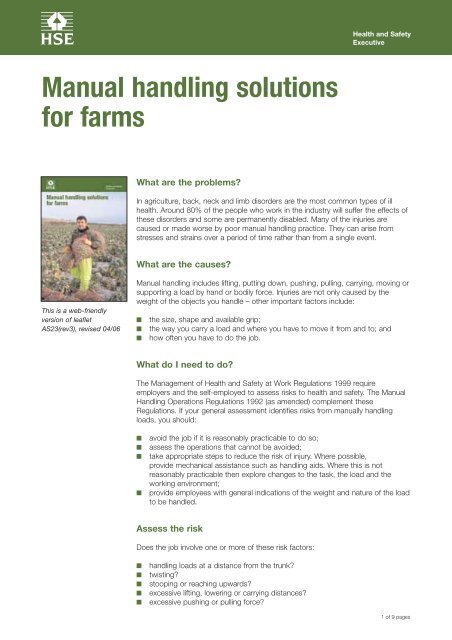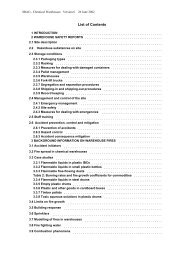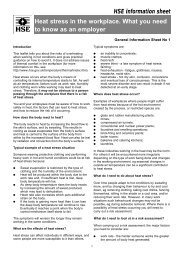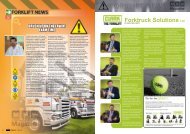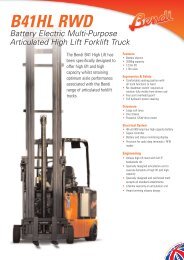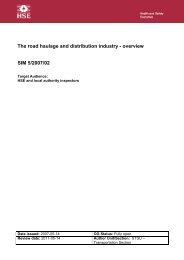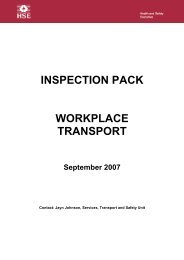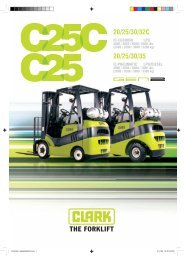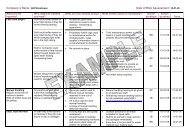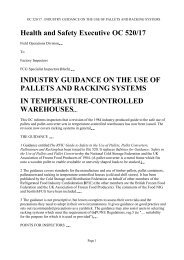Manual handling solutions for farms - Forktruck Solutions Ltd.
Manual handling solutions for farms - Forktruck Solutions Ltd.
Manual handling solutions for farms - Forktruck Solutions Ltd.
You also want an ePaper? Increase the reach of your titles
YUMPU automatically turns print PDFs into web optimized ePapers that Google loves.
Health and SafetyExecutive<strong>Manual</strong> <strong>handling</strong> <strong>solutions</strong><strong>for</strong> <strong>farms</strong>What are the problems?In agriculture, back, neck and limb disorders are the most common types of illhealth. Around 80% of the people who work in the industry will suffer the effects ofthese disorders and some are permanently disabled. Many of the injuries arecaused or made worse by poor manual <strong>handling</strong> practice. They can arise fromstresses and strains over a period of time rather than from a single event.What are the causes?This is a web-friendlyversion of leafletAS23(rev3), revised 04/06<strong>Manual</strong> <strong>handling</strong> includes lifting, putting down, pushing, pulling, carrying, moving orsupporting a load by hand or bodily <strong>for</strong>ce. Injuries are not only caused by theweight of the objects you handle – other important factors include:■■■the size, shape and available grip;the way you carry a load and where you have to move it from and to; andhow often you have to do the job.What do I need to do?The Management of Health and Safety at Work Regulations 1999 requireemployers and the self-employed to assess risks to health and safety. The <strong>Manual</strong>Handling Operations Regulations 1992 (as amended) complement theseRegulations. If your general assessment identifies risks from manually <strong>handling</strong>loads, you should:■■■■avoid the job if it is reasonably practicable to do so;assess the operations that cannot be avoided;take appropriate steps to reduce the risk of injury. Where possible,provide mechanical assistance such as <strong>handling</strong> aids. Where this is notreasonably practicable then explore changes to the task, the load and theworking environment;provide employees with general indications of the weight and nature of the loadto be handled.Assess the riskDoes the job involve one or more of these risk factors:■■■■■<strong>handling</strong> loads at a distance from the trunk?twisting?stooping or reaching upwards?excessive lifting, lowering or carrying distances?excessive pushing or pulling <strong>for</strong>ce?1 of 9 pages
Health and SafetyExecutive■■■■■■■positioning the load precisely?risk of sudden movement of loads?frequent or prolonged physical ef<strong>for</strong>t?insufficient rest or recovery periods?<strong>handling</strong> while seated?team <strong>handling</strong>?intensive work, tight deadlines and lack of control over the work andworking methods?Is the load:■■■■heavy, bulky or unwieldy?difficult to grasp?live, unstable, or with contents likely to move?sharp or hot?Where the <strong>handling</strong> is done, are there:■■■■■■space constraints preventing good posture?uneven, slippery or unstable floors?variations in level of floors or work surfaces?extremes of temperature or humidity?conditions causing ventilation problems or gusts of wind?poor lighting conditions?Consider the people involved. Does the job:■■■■require unusual strength, height etc?involve special risks <strong>for</strong> pregnant staff or anyone with a health problem?require special in<strong>for</strong>mation or training?conflict with personal protective equipment or other clothing?Take steps to reduce the risk of injuryThere are several practical <strong>solutions</strong> described in this leaflet that farmers can use tohelp reduce the likelihood of back or muscle problems.How much will it cost?The <strong>solutions</strong> to most manual <strong>handling</strong> risks will involve a combination of physicalmeasures, systems of work and operator training. Often the costs of these<strong>solutions</strong> are small and they are always tiny in comparison to the costs of disablingand painful injuries. Reducing risks from manual <strong>handling</strong> will usually improve theefficiency of the task, reduce labour costs and improve staff motivation.How do I prepare <strong>for</strong> manual <strong>handling</strong>?Even with some of the <strong>solutions</strong> described, you will still need to apply manualef<strong>for</strong>t. Whenever you have to move a load manually, training helps you to use yourbody more effectively and safely. Pure strength is no safeguard against manual<strong>handling</strong> injuries. Pregnancy, hernias or chronic back pain will all reduce yourcapacity <strong>for</strong> safe lifting. Better knowledge will help you to decide whether you cansafely move a load and how to move it.<strong>Manual</strong> <strong>handling</strong> <strong>solutions</strong> <strong>for</strong> <strong>farms</strong>2 of 9 pages
Health and SafetyExecutiveGood <strong>handling</strong> techniqueThis is no substitute <strong>for</strong> other risk-reduction steps such as lifting aids, improvingthe task, load or working environment. Good technique is a valuable addition toother risk-control measures but it requires training and practice, and should betailored to the particular <strong>handling</strong> operations being carried out.This advice is relevant to a lift using both hands that takes place in front of andclose to the body:■■■■■■■■■■■Stop and think. Plan the lift. Use <strong>handling</strong> aids. Remove obstructions.Keep the load close to the waist.Adopt a stable position.Ensure a good hold on the load.Bend the back, hips and knees slightly at the start of the lift. This is preferableto either fully flexing the back (stooping) or fully flexing the hips and knees(full/deep squatting).Don’t flex the back any further when lifting.Avoid twisting the back or leaning sideways.Keep the head up when <strong>handling</strong>.Move smoothly.Don’t lift or handle more than can be easily managed.Put down, then adjust.TrainingTraining will help you apply these rules to move loads safely. Employers have a dutyunder the Health and Safety at Work Act 1974 and the Management of Health andSafety at Work Regulations 1999 to provide their employees with health and safetyin<strong>for</strong>mation and training. This should be supplemented as necessary with morespecific in<strong>for</strong>mation and training on manual <strong>handling</strong> injury risks and prevention, aspart of the steps to reduce risk required by the <strong>Manual</strong> Handling OperationsRegulations 1992 (as amended).Points to consider■■■■The risk of injury may be increased where workers do not have in<strong>for</strong>mation ortraining to work safely.The use of mechanical <strong>handling</strong> aids may require training.Effective training will complement a safe system of work but is not a substitute<strong>for</strong> it.Training is available from a number of sources including Lantra Awards, traininggroups and local colleges. Tests to assess competence can be arrangedthrough the NPTC (see ‘Useful addresses’).Everyday <strong>solutions</strong>Physical <strong>solutions</strong> to manual <strong>handling</strong> problems are often low cost and easy toapply, such as simple but important improvements like levers and plat<strong>for</strong>ms.LeversIncreased mechanisation has led to less dependence on and knowledge aboutstraight<strong>for</strong>ward <strong>solutions</strong> like levers. Simple leverage can be a very cheap andeffective solution.<strong>Manual</strong> <strong>handling</strong> <strong>solutions</strong> <strong>for</strong> <strong>farms</strong>3 of 9 pages
Health and SafetyExecutiveSituations where you could use leverage include:■■■■■helping to make minor adjustments when hitching linkage-mounted machinesor hanging gates;inching a heavy item, eg a water tank, horizontally;using a spare post or crowbar when fencing <strong>for</strong> removing posts ortensioning wire;purpose-made tools <strong>for</strong> lifting manhole covers;long-handled wrenches or extension handles on some tools (taking care not todamage or over-tighten bolts).Plat<strong>for</strong>msTables and plat<strong>for</strong>ms, including temporary ones, can help ensure you are workingat the best height. Consider:■■■■a swing-out ‘bench’ over the tractor’s front weight frame <strong>for</strong> maintenance workat a remote site;a trolley or swing-out mounting on a tractor to present a heavy toolbox at aconvenient height and avoid lifting;a makeshift bench, eg of straw bales, to make livestock husbandry tasks easier;storing tractor weights at the same height as the mounting frame, eg on pallets(if you cannot handle them mechanically).Use a counterbalance or stored energy to help■■Consider applying a counterbalance weight to help when lifting loads such asheavy manhole lids. Remember not to compromise child safety where a lid orcover is secured shut by weight alone.Fit and maintain effective tailgate assistors (counterbalances, springs etc) onlivestock transporters.Make it easier to link equipment to tractorsFigure 1 Tractor weightsmounted on a frame toenable attachment byhydraulic link arms■ Position equipment accurately, using any slope to your advantage.■ Maintain and use the three-point linkage levelling box and the adjustment in atop link.■ Use quick attach/detach systems, eg with an ‘A’ frame (see Figure 1).■ Consider auto-attach and demount weight blocks in place of individualfront weights.Handling spare and dual tractor wheelsThe problemSpare tractor wheels are heavy, awkward loads that are frequently moved, eg whenfitting dual wheels or as part of changing between conventional, row crop and lowground pressure sizes. The ef<strong>for</strong>t needed to roll the wheel when it is vertical can bedeceptively small but once the wheel starts to lean, it quickly becomes unstableand a major manual <strong>handling</strong> problem.The risk of injury is even greater when you have to align wheel studs and can beincreased by the ground surface where the wheels are handled. It is tempting <strong>for</strong>one person to try to do the job alone and often people will leave wheels leaningagainst a wall when they have finished, making the next move possible but causingunacceptable risks to children.<strong>Manual</strong> <strong>handling</strong> <strong>solutions</strong> <strong>for</strong> <strong>farms</strong>4 of 9 pages
Health and SafetyExecutiveThe solutionUse a mechanical wheel handler, either as a free-standing unit or as an attachmenton a lift truck. Wheel handlers can lift, carry, rotate and tilt wheels to aid fitting andremoval from the tractor (see Figure 2).Figure 2 Handling device <strong>for</strong> wheel changing or fitting dual wheelsHandling bagged productsThe problemEven though most feed and fertiliser is now handled in bulk or big bags that canbe moved mechanically, there are still some 40 kg and 50 kg bags used, eg withseed corn.Where it is not feasible to change to bulk or big bag systems, eg with somespecialist, small-volume fertilisers or on smaller <strong>farms</strong> with limited mechanisation,considerable amounts of lifting can be required.Handling materials in 50 kg bags into a high hopper, such as on a seed drill or upsteps into a loft, involves increased risks. Where there is a poor working surface,eg slippery concrete or freshly cultivated soil, the problems are worse.<strong>Solutions</strong>Figure 3 Self-propelledtrolley being used totransport container plantsat a nursery■■■■■■■Use big bags or bulk systems with loaders, pipelines or augers to move thematerial wherever possible.Tote bins can help to mechanise and reduce manual ef<strong>for</strong>t.Aim to use the optimum spreader or drill hopper size <strong>for</strong> the scale of yourenterprise to increase the opportunities <strong>for</strong> bulk systems.Palletise 50 kg bags wherever and <strong>for</strong> as long as possible. Aim to keep thepallets intact from lorry to store to trailer to spreader or drill.Use the height of delivery trailers to your advantage so that bags are presentedat the best height <strong>for</strong> carrying.Position trailers and spreaders or drills so that bags can be moved to thehopper in one movement, avoiding difficult access over coulters etc.If you do have to move bags or bulk material by hand, especially over unevenor muck-laden ground, consider trolleys and feed barrows which have largerwheels and pneumatic tyres, or which are motorised (see Figure 3).<strong>Manual</strong> <strong>handling</strong> <strong>solutions</strong> <strong>for</strong> <strong>farms</strong>5 of 9 pages
Health and SafetyExecutiveLifting chemical and oil containersThe problemDespite many pesticide <strong>for</strong>mulations becoming less bulky, some packs of liquidproducts delivered onto <strong>farms</strong> are still difficult to handle, particularly into storesand other buildings. Some containers which provide excellent control of chemicalrisks through closed transfer technology can cause manual <strong>handling</strong> problems ifyou don’t properly plan how you will move them and use the right equipment, eg<strong>for</strong> <strong>handling</strong> and agitation. Larger (eg 200 l) oil or dairy chemical drums avoid muchmanual <strong>handling</strong> but still have to be moved from a delivery lorry to where theywill be used.<strong>Solutions</strong>Figure 4 Drum cradle■ Use a drum cradle to move and tilt larger containers (see Figure 4).■ Plan your storage arrangements to reduce the distance containers have tobe moved.■ Install ramps at the entrance to chemical stores to allow rolling of containers.■ Use bulk containers that are only handled by a lift truck.■ Fit low-level filling points on sprayers – never lift large containers up a ladder tothe top lid.■ Use automated dairy bulk-tank washers to reduce chemical <strong>handling</strong>.■ Always consider pumps, syphons or gravity taps to remove the contents.■ Use the manual <strong>handling</strong> risk as one of your criteria when deciding whichchemical <strong>for</strong>mulation is most appropriate <strong>for</strong> your farm.Handling and casting sheepThe problemHandling sheep regularly <strong>for</strong> routine flock management involves a lot of manualef<strong>for</strong>t. One example is casting adult sheep <strong>for</strong> foot trimming. The risks arise bothfrom the ef<strong>for</strong>t in turning the sheep and then from the awkward posture reachingdown to the animal.<strong>Solutions</strong>As with many risks, avoiding the job or doing it less often is the preferred solution,eg avoid introducing footrot, vaccinate, use a footbath, or where possible allowaccess to stony ground. However, where sheep have to be cast, and especiallywhere this involves a group of animals, a turnover crate will reduce the manual<strong>handling</strong> risks. A turnover crate can also be used in conjunction with a <strong>handling</strong>system to aid the flow of animals, enable shedding and with some, present thesheep on an elevated plat<strong>for</strong>m to reduce bending when drenching, dagging etc(see Figure 5). A number of different designs are available.Consider a turnover crate and <strong>handling</strong> system to:Figure 5 Sheepturnover crate■■■■present the sheep at the right height and the right way up;make sheep struggle less;avoid lifting <strong>for</strong>ces – good designs rotate without raising the sheep’s centre ofgravity too much;avoid sitting sheep on dirty ground, contaminating wool and risking flystrike.<strong>Manual</strong> <strong>handling</strong> <strong>solutions</strong> <strong>for</strong> <strong>farms</strong>6 of 9 pages
Health and SafetyExecutiveSheep shearingThe problemShearing is a high-risk job involving the entire adult flock <strong>for</strong> a short time andrequiring substantial manual ef<strong>for</strong>t. While contractors shearing many thousands ofsheep may be considered at higher risk, often a farmer who is less practised at thejob will have a poorer technique and work in less suitable surroundings.<strong>Solutions</strong>Traditionally, the physical options <strong>for</strong> reducing the risks during shearing have beenlimited to the workstation layout. The best practice of presenting sheep to theshearer in a close, small pen and allowing rapid exit of the shorn animal, awayfrom the wrapping point has been achieved in purpose-designed shearing shedsor mobile shearing trailers. However, these features can be employed at anyshearing site.Figure 6 Sheep shearerusing back-aid<strong>Manual</strong> ef<strong>for</strong>t can be further reduced by a shearing back-aid (see Figure 6).Back-aids are widely used in Australia and in other sheep-rearing countries and areavailable in the UK. The ‘Warrie back-aid’® helps by carrying some of the shearer’supper body weight while they are bent over the sheep.The device uses sound ergonomic principles and in a well-designed workplace canmake the difference between lifelong back problems and years of skilled shearing.Bale <strong>handling</strong>Many farming systems involve <strong>handling</strong> hay, silage or straw bales. The mostimportant step is to match the optimum bale type to your available storage andsystem of use. While silage bales will normally be handled entirely mechanically,others may not.Conventional balesIf you cannot use larger bales, eg if you farm a smaller unit or, as in some parts ofthe country where the fields, storage facilities and methods of using hay or strawwould not support bigger bales, you need to make sure you have controlled therisks properly.Problems■■■■Transporting, putting into store and using conventional bales on small units,eg where bales are stored in small stone barns, lofts etc.Outdoor stacks with bales which are spoiled by rain and very heavy.Handling small bales into straw choppers with a high hopper (necessary toprotect against contact with blades).Moving pedestrian bale choppers around the farm.<strong>Solutions</strong>Figure 7 Tractor-mountedstraw chopper <strong>for</strong> spreadingfresh bedding■■■■■Use traditional aids such as pitch<strong>for</strong>ks, bale hooks, or slat elevators.Store bales close to where you will use them, eg over livestock pens.Use sledges, accumulators, grabs and other mechanical aids to handle bales ingroups where possible.Try to use storage buildings which allow easy access <strong>for</strong> a materials handler oraccumulator trailer.Where possible switch to large-bale systems.<strong>Manual</strong> <strong>handling</strong> <strong>solutions</strong> <strong>for</strong> <strong>farms</strong>7 of 9 pages
Health and SafetyExecutiveRound and large square balesWhile most <strong>handling</strong> will be mechanical, these bales sometimes have to be movedby hand, eg in livestock pens.Problems■■■■Unrolling round bales in less suitable livestock pens, especially whenturning corners.Restricted access into buildings such as cubicle sheds.Playful cattle can be an additional hazard and may need to be excluded if youhave to go into the pen.When large square bales of poor-quality straw are cut, the flakes canthemselves be very heavy.<strong>Solutions</strong>Figure 8Mechanised feeding■ Use chopped straw from a tractor-mounted chopper (see Figure 7).■ Consider an automated unwrapper or other mechanised feeding process(see Figure 8).■ Use a purpose-designed carrier – effectively fitting wheels to the bale.■ Use a loader attachment that allows large square bales to be graduallyreleased <strong>for</strong> bedding loose yards.■ Break open bales outside areas with restricted access and move the flakes ona trailer or trolley with large wheels.■ Consider alternative bedding systems using wood shavings, rubber mats orwater beds in cubicles.<strong>Manual</strong> <strong>handling</strong> <strong>solutions</strong> <strong>for</strong> <strong>farms</strong>8 of 9 pages
Health and SafetyExecutiveUseful addressesSpecific advice on training is available from colleges and from:Lantra Awards, Stoneleigh Park, Kenilworth, Warwickshire CV8 2LG.Tel: 02476 419703 Fax: 02476 411655.In<strong>for</strong>mation on competence assessment can be obtained from:NPTC, Stoneleigh Park, Kenilworth, Warwickshire CV8 2LG.Tel: 02476 857300 Fax: 02476 696128Further reading<strong>Manual</strong> <strong>handling</strong>. <strong>Manual</strong> Handling Operations Regulations 1992 (as amended).Guidance on Regulations L23 (Third edition) HSE Books 2004 ISBN 0 7176 2823 X<strong>Manual</strong> <strong>handling</strong>: <strong>Solutions</strong> you can handle HSG115HSE Books 1994 ISBN 0 7176 0693 7Handling and stacking bales in agriculture Leaflet INDG125(rev1)HSE Books 1998 (single copy free)Getting to grips with manual <strong>handling</strong>: A short guide Leaflet INDG143(rev2)HSE Books 2004 (single copy free or priced packs of 15 ISBN 0 7176 2828 0)<strong>Manual</strong> <strong>handling</strong> assessment charts Leaflet INDG383HSE Books 2003 (single copy free or priced packs of 10 ISBN 0 7176 2741 1)Are you making the best use of lifting and <strong>handling</strong> aids? Leaflet INDG398 HSEBooks 2004 (single copy free or priced packs of 15 ISBN 0 7176 2900 7)Further in<strong>for</strong>mationHSE priced and free publications are available by mail order from HSE Books,PO Box 1999, Sudbury, Suffolk CO10 2WATel: 01787 881165 Fax: 01787 313995Website: www.hsebooks.co.uk (HSE priced publications are also available frombookshops and free leaflets can be downloaded from HSE’s website:www.hse.gov.uk.)For in<strong>for</strong>mation about health and safety ring HSE’s InfolineTel: 0845 345 0055 Fax: 0845 408 9566 Textphone: 0845 408 9577e-mail: hse.infoline@natbrit.com or write to HSE In<strong>for</strong>mation Services,Caerphilly Business Park, Caerphilly CF83 3GG.This leaflet contains notes on good practice which are not compulsory butwhich you may find helpful in considering what you need to do.This leaflet is available in priced packs of 15 from HSE Books, ISBN 0 7176 6186 5.Single free copies are also available from HSE Books.© Crown copyright This publication may be freely reproduced, except <strong>for</strong>advertising, endorsement or commercial purposes. First published 04/06.Please acknowledge the source as HSE.Published by the Health and Safety Executive AS23(rev3) 04/069 of 9 pages


